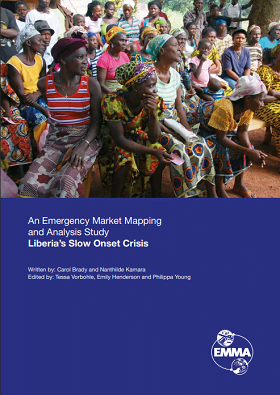An Emergency Market Mapping and Analysis Study Liberia’s Slow Onset Crisis
In 2010, contested elections in neighbouring Côte d’Ivoire, and the violence that ensued, forced hundreds of thousands of people from their homes. As of 7th of July 2011, the United Nations High Commissioner for Refugees (UNHCR) had counted a total of 153,000 refugees crossing the border into Liberia. Many of these refugees found sanctuary in Grand Gedeh County, bordering Côte d’Ivoire to the west.
Grand Gedeh, in the southeast of Liberia, is one of the counties most affected by chronic food insecurity, with 42% of the population being food insecureii and 43.4% of the population suffering from stunted growth. Grand Gedeh’s agricultural production is low, as low level land cultivation is still relatively undeveloped, meaning that people rely on other sources of food and income. Traditionally, communities are able to harvest enough food to last for only four months each year, turning to both the markets, which provide 69% of food in the county, and the collection of wild food when these supplies run out.
From early March 2011, waves of refugees, fleeing the fighting and instability in Côte d’Ivoire, crossed the border into Grand Gedeh County, largely settling along the border and the main road. By July, refugees in this area numbered 74,000, with the majority of refugees (up to two thirds) hosted by communities. As many Ivorian families had hosted Liberian refugees during the Liberian war, many Liberian families were willing to host Ivoirians in return. Despite the predominance of refugees staying with host families, there were still significant numbers of refugees in camps. As the crisis ensued, a growing number of villages were affected by the influx. Already limited resources were becoming increasingly strained, severely affecting the self-sufficiency, food security and the short to medium-term livelihoods of the host communities. Food and seed stocks were being depleted, meaning that, without assistance, many farmers would not be able to sow in time for the next harvest. In the context of chronic vulnerability to food insecurity and the undue strain posed by the influx of refugees, the lean season was hitting early. Prior to OGB’s interventions, food assistance had not been sufficient in quantity and in quality to meet the needs of refugees and little had been done to address the shortages faced by host communities.
This case study presents the EMMA market assessment that was carried out between the 12th and the 24th of April 2011 in Liberia’s slow onset crisis, in which refugees were continuing to arrive at the time of the EMMA market assessment.
The EMMA took a total of thirteen working days, including
two days of training, eight days of data collection, and three days to finalize and disseminate the report.
This case study gives a global overview of how the EMMA was lead and analyses its successes and lessons learnt.



